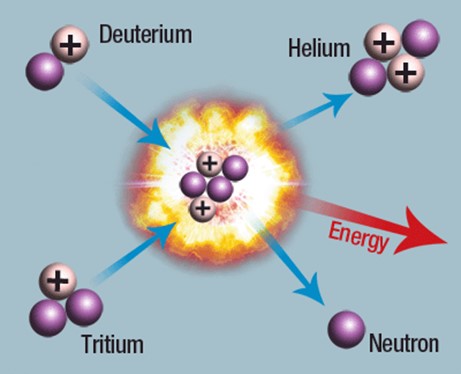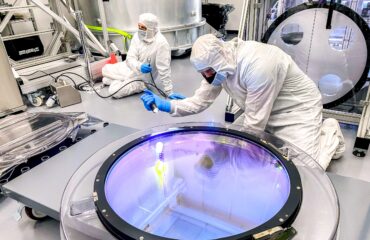
The Sun produces energy by nuclear fusion. NASA
By Mariana Meneses
For a long time, one of humanity’s dreams has been to do what only stars have been capable of: to create energy from nuclear fusion.
A fusion reactor could potentially power four times as many homes as a fission reactor, and four million times as many homes as an oil or coal plant with the same amount of fuel. After recent developments in fusion energy production, how close are we to limitless clean energy?
Nuclear fusion occurs when two lighter atoms join, or fuse, into a heavier atom, a process which liberates a tremendous amount of energy in the form of heat. In the core of a star like our Sun, hydrogen atoms fuse to make helium, generating the energy that powers life on Earth. For fusion to happen, the hydrogen protons, which carry a positive electric charge in their atomic nucleus, must collide violently in extreme conditions of heat and pressure, which, in the Sun, are the result of gravity.
Here on Earth, scientists use the hydrogen isotopes deuterium and tritium, which are considered the best materials for nuclear fusion.
Isotopes of an element like hydrogen contain different numbers of neutrons, which carry no electrical charge, in the nucleus.
Experiments have been conducted for decades, as researchers have been looking for ways of producing fusion energy at a large scale for commercial use. The main challenge is that the extreme conditions needed for this reaction to occur consume a lot of power, which until recently has been greater than the amount of energy released when fusion is achieved.
“Deuterium (or hydrogen-2, also known as heavy hydrogen) is one of two stable isotopes of hydrogen (the other being protium, or hydrogen-1). The nucleus of a deuterium atom contains one proton and one neutron, whereas the far more common protium has no neutrons in the nucleus. Deuterium (…) accounts for approximately 0.0156% (0.0312% by mass) of all the naturally occurring hydrogen in the oceans, while protium accounts for more than 99.98%” (Wikipedia).
“Tritium (or hydrogen-3) is a rare and radioactive isotope of hydrogen. The nucleus of tritium contains one proton and two neutrons. (…) Naturally occurring tritium is extremely rare on Earth. The atmosphere has only trace amounts, formed by the interaction of its gases with cosmic rays. It can be produced artificially by irradiating lithium metal or lithium-bearing ceramic pebbles in a nuclear reactor and is a low-abundance byproduct in normal operations of nuclear reactors” (Wikipedia).

Schematics of the process of nuclear fusion. Wikimedia Commons
As popular science communicator Dr. Neil DeGrasse Tyson explains in his YouTube channel Star Talk, “The problem over all these years is that, of course, we know how to make fusion. We’ve known how to make fusion since about 1949 or something. (…) The challenge is not how you make fusion. It’s how you control it.”
The first demonstration of human-generated fusion that Dr. DeGrasse Tyson was referring to was the hydrogen bomb.
In 2021, scientists at the National Ignition Facility (NIF) went a step further to achieving the goal of harnessing energy from nuclear fusion when they dramatically increased the fusion output of their experiments by 2500%. However, one important goal had not been met: to reach ignition or, in other words, to generate more fusion energy than the laser energy required to power the process.
“The National Ignition Facility (NIF) is a laser-based inertial confinement fusion (ICF) research device, located at Lawrence Livermore National Laboratory in Livermore, California, United States. NIF is the largest and most powerful ICF device built to date” (Wikipedia).
On December 2022, the U.S. Department of Energy announced a breakthrough.
Researchers from the Lawrence Livermore National Laboratory, in California, used 192 lasers on hydrogen isotopes kept in an overheated plasma state to fuse atoms of hydrogen. They succeeded in producing fusion ignition with an energy gain factor of 1.5, meaning that they managed to create 50% more fusion energy than the laser energy used.
“At the temperatures required for (…) fusion energy, all matter is in the form of plasma. (…) Plasma is superheated matter – so hot that the electrons are ripped away from the atoms forming an ionized gas (…) – a soup of positively charged particles (ions) and negatively charged particles (electrons). (…) In the night sky, plasma glows in the form of stars” (Plasma Science and Fusion Center, MIT).

“A tokamak is a device which uses a powerful magnetic field to confine plasma in the shape of a torus. The tokamak is one of several types of magnetic confinement devices being developed to produce controlled thermonuclear fusion power”. Wikimedia Commons
From 2021 to 2022, there was an increase in fusion energy production relative to the laser energy used.
Although the news spurred much optimism for what many believe to be the future of energy production, some experts warn that we still face a long road before fusion energy is commercially viable.
The main problem is that the process must not only to generate more energy than the laser energy used to collide hydrogen protons, it also needs to “pay” for the energy used to power the laser system in the first place. With that in mind, physicist Dr. Tom Hartsfield has argued for Big Think that this development, “heralded as ’game-changing’, ‘transformative’, and ‘a moment of history’, (…) is not a meaningful breakthrough for practical, commercial fusion power: NIF still drains at least 130 times more energy from the power grid than it produces.”
The Trouble With Tritium
As Kim Budil, director of the Lawrence Livermore National Laboratory in Livermore explains for Reuters: “This is one igniting capsule, one time and to realize commercial fusion energy, you have to (…) produce many, many fusion ignition events per minute and you have to have a robust system of drivers to enable that.”
While we still need to increase the fusion output dramatically, we also have to solve the problem of tritium supply: it’s an extremely rare material. As Dr. Hartsfield also explains, the world has only a small amount of tritium, which is very expensive, and to run a commercial operation like NIF we would need a lot of it every day
Nuclear fusion energy is considered one of the main alternatives to clean energy in the future, mainly due to the low generation of waste and the fact that it does not release climate-damaging greenhouse gases. Furthermore, unlike fission, which splits atoms instead of joining them in our present nuclear reactors, fusion energy does not produce long-lived radioactive waste and is not susceptible to nuclear meltdowns.
Scientists believe they will be able to produce the tritium needed, but it will be a challenge and requires more time to research.
Lawrence Livermore is not the only place where scientists are working towards the goal of commercially viable fusion energy.
The Joint European Torus (JET) research facility in Oxfordshire, UK, set a record fusion pulse in 2021, as you can see in the video below:
A more advanced version of JET, known as ITER, is now being built in France by a collaboration of thirty-five countries.
According to the European Commission: “Further in the future, the next step beyond ITER will be a demonstration power plant known as DEMO, designed to send electricity into the grid – leading on to fusion plants becoming a commercial and industrial reality.”
A recently published research paper, led by Chang Liu, from the Princeton Plasma Physics Laboratory, indicates another potential victory towards the goal of scalable nuclear energy.
The researchers discovered a promising way to control runaway electrons in fusion devices called tokamaks, by using a special type of plasma wave called Alfvén waves. Normally, Alfvén waves make it harder to keep high-energy particles inside tokamaks, but in this case, they actually helped by stopping the runaway electrons from going out of control. This discovery could make tokamak designs safer and more efficient. In fusion, where plasma (super-hot matter made of electrons and ions) combines to create energy like the Sun, preventing disruptions caused by runaway electrons is crucial.
This breakthrough could benefit projects like ITER in France, which aims to show that fusion energy is practical and may lead us closer to using fusion power in the future. As reported by Phys.org, the researchers are planning more experiments to build on these exciting findings.
To Professor Tony Donné, program manager of the EUROfusion project, fusion energy is fundamental for our future: “I’m not convinced that by 2050 we can make the carbon dioxide transition with only renewables, and we need other things.”
The recent developments are closer to proof of concept than to commercial usage. But Dr. Neil DeGrasse Tyson believes that, “if the physics works, then it’s just a matter of time.”
To him, “the Holy Grail is: can we undergo fusion in a controlled way, where one day you might be able to (…) have fusion reactors in every car? That would transform the civilization, even regardless of the carbon footprint that it doesn’t have. But it also happens to not have a carbon footprint, so we could stave off this growth of fossil fuel burning, and greenhouse gases (…) We’ll still have to recover from the damage we’ve already done because a lot of the carbon dioxide got up took into the oceans (…). But it is the future.”
Interested in exploring related topics? Discover these recommended TQR articles:
- Harnessing Ocean Power: New Technologies Hold Promise for Clean and Cost-Effective Energy
- Clean Technologies and Technologies That Clean: Undoing the Climate Damage We Have Caused
- The Surprising Connection Between Human Bodies and Supernova Explosions
- A Job for the Machines: Using Artificial Intelligence to Advance Nuclear Fusion
- Chasing Nuclear Fusion
- Revolutionizing Food Production to Power a Growing World Population



